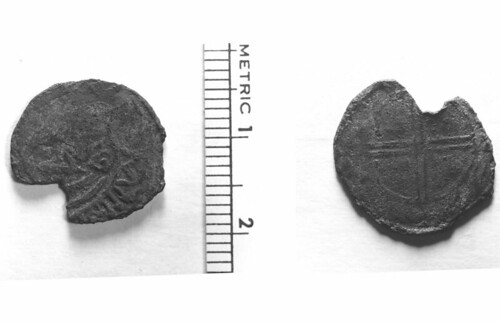
PREV ARTICLE
NEXT ARTICLE
FULL ISSUE
PREV FULL ISSUE
THE MYSTERY OF MAINE’S VIKING PENNYOn December 21, 2017 Atlas Obscura published a lengthy article about the Goddard Viking Penny found in Maine. It's a topic we've discussed before in The
E-Sylum; see below for links to earlier articles. Here's a short excerpt, but be sure to read the complete article online. let us know what you think! -Editor
Goddard had invited them to explore his shoreline property, and there, on a natural terrace about eight feet above the high tide line, they found stone chips, knives, and fire pits, along with an abundance of other unexpected artifacts. Each summer for many years, Mellgren and Runge returned to excavate the “Goddard Site,” with little help from professional archaeologists. In the second summer, they produced the coin. For two decades, based on an analysis by a friend in a numismatics club, Mellgren described it as a coin minted in 12th-century England, and no one questioned that identification. The discovery should have been noteworthy—there’s no good explanation for how a medieval English coin could have crossed the Atlantic—but Mellgren never sought wider attention for the find. It was a curiosity to show off to friends and his son’s classmates, until, in 1978, a scrappy regional bulletin published a picture of the coin and an article titled, “Were the English the First to Discover America?” That picture found its way to a well-known London dealer, who recognized at once that the coin could not have come from England. Two weeks after Mellgren died, the coin’s reidentification swept into the news. It was a Norse penny, made between 1065 and 1093—evidence for Viking contact with North America centuries before Columbus. All of sudden, experts from around the world began taking a careful look at the details of Mellgren’s story. Of many objects purported to prove a Viking presence in North America, only the artifacts painstakingly excavated at L’Anse aux Meadows, in Newfoundland, have stood up to investigation. The rest—the Beardmore relics, the Vinland Map, the notorious Kensington Rune Stone—are all considered hoaxes. Since 1978, no one has questioned that the Mellgren coin is an authentic Norse penny, made in medieval Scandinavia. But 60 years after Mellgren’s find, archaeologists and numismatic experts are still asking how in the world this small, worn coin got to Maine. ON FEBRUARY 6, 1979, KOLBJØRN Skaare, a Norwegian numismatist with a tall, wide forehead, walked into the Maine State Museum to see the coin. Just a few years earlier, he had published Coins and Coinage in Viking-Age Norway, a doctoral thesis that grew from the decade-plus he had spent as a keeper at the University of Oslo’s Coin Cabinet. The first specialist to examine the coin in person, he had just a day with it before Bruce J. Bourque, the museum’s lead archaeologist, had to address the national press. Skaare saw “a dark-grey, fragmentary piece,” he later wrote. It had not been found whole, and the coin had continued to shed tiny bits since it was first weighed. A little less than two-thirds of an inch in diameter, it had a cross on one side, with two horizontal lines, and on the other side “an animal-like figure in a rather barbarous design,” with a curved throat and hair like a horse’s mane. In his opinion, it was an authentic Norwegian penny from the second half of the 11th century. Medieval Norse coins aren’t an unheard-of rarity. In 1879, farmers in a potato field in Gressli, Norway, had discovered a hoard containing 2,301 coins from the reign of Olaf the Peaceful, the period Mellgren’s penny dated to. Many of those coins were exact duplicates of each other, and the University of Oslo had sold off the extras between the 1880s and the 1920s. But the Mellgren coin isn’t quite like the ones from the Gressli hoard, which have been described as looking like they’re newly minted. The Maine penny was much more worn, and not an exact duplicate of any coin in the university’s collection. In the 1970s, many experts were inclined to believe the coin was a genuine discovery.  Coins from the Gressli hoard. In hoaxes and other overinterpreted archaeological finds, usually “the hopes outrun the evidence from the very start,” writes archaeologist Stephen Williams in Fantastic Archaeology. But in this case, Mellgren didn’t try to attract attention to the penny. Whatever hopes he had about the significance of his find, he kept them quiet. “It’s reasonable to suspect that the Norse penny was a plant,” says Bourque, who only recently stepped down as the Maine State Museum’s chief archaeologist. “The balance of the evidence argues it’s an honest find.” After Mellgren’s coin was identified as Norse, the Maine State Museum sent a team of professional archaeologists to the Goddard Site to better understand the context the coin had come from. While no other Norse artifact has ever been found there, the site did hold surprises—artifacts attesting to an explosion of trade contact between Native American groups, stretching from the eastern Great Lakes up to Labrador. At the same time the coin shows up, for instance, archery first appears in the region. “The site has an unspeakably dense concentration of archers,” says Bourque. Excavations have turned up thousands of arrowheads, along with mounds of pottery sherds and stones that come from hundreds of miles away. “It’s off the charts,” he says. “The real mystery is—what the hell is going on at the site at the time?” To Bourque, the coin is a clue in this other mystery. All sorts of objects that seem out of place in 12th-century Maine show up in this one spot, as if it were site of a pre-Columbian World’s Fair for northeastern coastal America, from Lake Erie to Newfoundland. Unlike the sagas—all story, little evidence—this site is full of interesting evidence in search of a story. To read the complete article, see: To read the earlier E-Sylum articles, see:  Wayne Homren, Editor The Numismatic Bibliomania Society is a non-profit organization promoting numismatic literature. See our web site at coinbooks.org. To submit items for publication in The E-Sylum, write to the Editor at this address: whomren@gmail.com To subscribe go to: https://my.binhost.com/lists/listinfo/esylum All Rights Reserved. NBS Home Page Contact the NBS webmaster 
|
